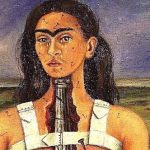 Mysteries
Mysteries  Mysteries
Mysteries  History
History 10 Surprising Stories About the Texas Rangers
 Humans
Humans 10 Philosophers Who Were Driven Mad by Their Own Theories
 Miscellaneous
Miscellaneous 10 Video-Game-Worthy Weapons and Armors from History
 Weird Stuff
Weird Stuff 10 Psychics Who Accurately Predicted Wartime Events
 The Arts
The Arts 10 Pieces of Art Inspired by a Broken Heart
 Health
Health 10 Science Fiction-Sounding New Medical Treatments
 History
History 10 Surprising Facts About the Father of Submarine Warfare
 Space
Space Ten Astonishing New Insights into Alien Worlds
 Weird Stuff
Weird Stuff 10 Bizarre Summer Solstice Rituals Still Practiced Today
 Mysteries
Mysteries Top 10 Haunting Facts About the Ghost Ship MV Alta
 History
History 10 Surprising Stories About the Texas Rangers
 Humans
Humans 10 Philosophers Who Were Driven Mad by Their Own Theories
Who's Behind Listverse?

Jamie Frater
Head Editor
Jamie founded Listverse due to an insatiable desire to share fascinating, obscure, and bizarre facts. He has been a guest speaker on numerous national radio and television stations and is a five time published author.
More About Us Miscellaneous
Miscellaneous 10 Video-Game-Worthy Weapons and Armors from History
 Weird Stuff
Weird Stuff 10 Psychics Who Accurately Predicted Wartime Events
 The Arts
The Arts 10 Pieces of Art Inspired by a Broken Heart
 Health
Health 10 Science Fiction-Sounding New Medical Treatments
 History
History 10 Surprising Facts About the Father of Submarine Warfare
 Space
Space Ten Astonishing New Insights into Alien Worlds
 Weird Stuff
Weird Stuff 10 Bizarre Summer Solstice Rituals Still Practiced Today
10 Operas Inspired by Wild Real-World Events
Artists inspired by real life are famously allowed to exercise “poetic license.” That is, to not let the truth get in the way of a good story. But it sure is easier if the story is already good. And when it comes to opera, where the story is one of several art forms that are combined to create supercharged drama on the stage, it is even better if it is absurd, scandalous, or fantastic.
While many composers adapted myths, plays, and books into operas, some had a keen eye for sensational real-world events both in their own time and from history. Here are ten real-life tales and scenarios that were so wild they were turned into operas.
Related: Top 10 Underrated Film Scores By Famous Composers
10 Orango
By the beginning of the 20th century, the Russian biologist Ilya Ivanov had already had a successful career. He had been to study in Paris and had helped breed better horses by using artificial insemination. But by 1910, he had a new goal. He wanted to create human-ape hybrids that would be smarter, stronger, and less sickly than either humans or apes.
When the Soviets came to power, Ivanov got government funding and brought four chimpanzees to Russia, which he used to try to inseminate a mentally unwell woman. Before his vile experiment ended in failure, he was visited at his lab by the composer Dmitri Shostakovich.
What Shostakovich saw must have stuck with him because, in 1932, he wrote Orango—a sci-fi opera that tells the story of a human-ape hybrid that has been sold to a Soviet circus. Shostakovich threw the work away for an unknown reason, but the first 35 minutes of music were recovered in 2004.[1]
9 Weisse Rose
The guillotine–the deadly decapitating device best known for relieving French royalty of their heads–was also used by the Nazis during World War II. Among the many unfortunate folk who met their fate this way were Hans Scholl, 24, and his younger sister Sophie, 21. They were not Jewish; in fact, they had been leaders in the Hitler Youth as teenagers. But they came to reject that organization and instead joined the White Rose.
This was a group of six students from the University of Munich and one professor. With the help of some unaffiliated supporters, they distributed anti-Nazi leaflets designed to raise awareness of Nazi atrocities among middle-class Germans. Hans and Sophie were arrested while distributing leaflets at the university in February 1943. Four days later, they were executed after a show trial.
The members of the White Rose are now rightly seen as German heroes, and plays and movies have told their story. So has an opera by the East German composer Udo Zimmermann. Weisse Rose was an instant hit, being performed in over 30 cities just two years after its premiere.[2]
8 Eliogabalo
To condemn emperors they did not like, Roman historians had a few favorite accusations they would make about them. Incest was one, and fighting as a gladiator was another. The most important thing is that they were believable. But when writing about the brief reign of Emperor Heliogabalus, they accused him of prostituting himself and asking a physician about changing his gender. These were outrageous claims, and even if they were not true, what kind of man was he if these were plausible?
Well, in his four scandalous years in charge, he had at least four wives. That was clearly not enough for him, though, as he repeatedly bedded the wives of others, as well as numerous men. His excesses made him such an ineffective emperor that his own Praetorian Guard killed him. His story is certainly a salacious one, which is probably why the 17th-century opera Eliogabalo only received its premiere in 2007. It was composed by Francesco Cavalli in 1667, but his local theater in Venice refused to perform it.[3]
7 The Eternity Man
Before the world ever knew about Banksy, the Australian city of Sydney had its own street-art phenomenon—”The Eternity Man.” This moniker comes from the famous “one-word sermon” he chalked an amazing half a million times on the streets during the 1950s and ’60s.
However, his real identity was no mystery. His name was Arthur Stace, and he had been a petty criminal and alcoholic for most of his life before he converted to Christianity in 1930. He then quit alcohol and dedicated his life to converting others. One of his methods was to go out at night and write “Eternity” all over the city. He wanted to make people think about how they were preparing for it.
In his honor, the word “Eternity” lit up Sydney Harbour Bridge when Australia welcomed the new millennium. His story was also adapted into a short opera called The Eternity Man by the Australian composer Jonathan Mills. It follows Stace from his time working as a police lookout at a brothel through his occupation for which he would become famous.[4]
6 The Death of Klinghoffer
Few works of art can provoke protests and threats like John Adams’s The Death of Klinghoffer. The opera premiered in 1991, just six years after the event on which it is based. That was the hijacking of the MS Achille Lauro, an Italian cruise ship, by members of the Palestinian Liberation Front in October 1985.
The four hijackers posed as passengers, and after the ship had docked in Egypt and most passengers had gone sightseeing, they forced the boat back out to sea. Among the 97 unlucky passengers left onboard was Leon Klinghoffer. He was shot and thrown overboard, ostensibly because he was Jewish; being an elderly man in a wheelchair, he clearly posed no threat. Everybody else was let go two days later, and the hijackers were arrested while flying out of Egypt.
The opera’s controversy stems from the depiction of the hijackers, with some people accusing it of stretching beyond sympathetic to the point of being pro-extremist.[5]
5 The Trial of Mary Lincoln
It is not unheard of for children to loudly question a parent’s sanity—many parents with teenagers can confirm that. But it is another thing altogether to take your mother—a former first lady, no less—to court and convince a jury that she is insane. Yet that is what happened to Mary Todd Lincoln, the widow of Abraham Lincoln.
While visiting Florida in 1875, she became overwhelmed with fear that her son Robert was ill. She rushed to Chicago to see Robert, who was perfectly fine but concerned about his mother’s erratic behavior. He concluded that she needed to stay in a sanitarium to rest. But in the state of Illinois, a jury trial was needed before that could happen.
After a three-hour trial, the jury was convinced, and Mary spent three months inside one while Robert took control of her estate. Whether she was truly ill is unclear. The composer Thomas Pasatieri adapted this episode from Mary’s life into an opera. It was designed for television broadcast and received its premiere on PBS in February 1972.[6]
4 Lizzie Borden
It is surprising that it took until 1965 to turn the Lizzie Borden tale into an opera. The horrific 1892 double homicide had already been turned into books, plays, and a ballet by then. All portray Lizzie as the axe-wielding Massachusetts murderer who butchered her father and stepmother, and Jack Beeson’s opera is no different.
In real life, she was acquitted, but she remains the prime suspect to this day. The opera traces Lizzie’s journey from a Sunday School teacher to a psychotic axe-swinging killer. It attempts to explain the murders as a result of her fear about not being married, her father’s forceful personality, and her stepmother’s selfishness and spite. Her father is also portrayed as stingy, and there might be some truth to this. Lizzie and her sister were said to often clash with him over money.
As Lizzie’s terrifying transformation gets underway, the opera builds from a gentle start to its intense and bloody climax.[7]
3 Paavo the Great. Great Race. Great Dream.
Although it is long and unusual, Paavo the Great. Great Race. Great Dream. really is the title of this contemporary opera. Its subject is unusual too; it is about sports. Specifically, it is about Paavo Nurmi, one of the world’s first sports stars. “The Flying Finn” had a magical career as a middle-distance runner in the 1920s, winning nine Olympic gold medals and three silvers and setting 25 world records. That earned him his place among Finland’s national heroes, but of course, an operatic hero requires some tragedy in their life.
For Nurmi, that was World War II, causing the 1940 Helsinki Games to be canceled, dashing his dream of winning the marathon in front of a home crowd. In 2000, composer Tuomas Kantelinen set Nurmi’s story to music, and it was performed in the Helsinki Olympic Stadium. The lead even had to run a few laps during the performance, which also featured an army helicopter and burning haystacks.[8]
2 Song from the Uproar: The Lives & Deaths of Isabelle Eberhardt
The “Lives and Deaths” of the title of this opera refers to the many large lifestyle shifts Isabelle Eberhardt undertook in her short life. The trailblazing Swiss writer and adventurer lived from 1877 to 1904, never even reaching her thirtieth birthday. Yet she was able to pack several lives’ worth of experiences into her own.
Her first big change was moving to Algeria, where she would often wander about disguised as a man. She would write about her experiences in diaries, which were later published after her death. She smoked, drank, and had numerous affairs, then joined a Sufi brotherhood, which she was accused of spying on for the French authorities.
Eberhardt survived an assassination attempt, syphilis, and malaria but tragically drowned in a flash flood at the age of 27. Given the operatic nature of her life, it is surprising that it took more than a century to appear on stage. In 2012, the New York-based composer Missy Mazzoli took on the task of adapting it. Song from the Uproar, which only has one role, was the result.[9]
1 The Life and Death of Alexander Litvinenko
Alexander Litvinenko’s story was also operatic, but it took much less time before it was put on stage. Alexander was a former Russian spy who defected to the UK and became one of Putin’s top critics. He worked publicly as a journalist, but he was also employed as a British spy due to his expertise in Russian organized crime.
In November 2006, he was due to testify about Russian criminals in Spain and their links to top Russian politicians. Before he could get there, though, he met two of his former associates from Russia for tea in London’s Millennium Hotel. They slipped a tiny amount of radioactive polonium-210 into his tea. Three weeks later, he died from radiation poisoning.
With facts like these—not to mention a heartbroken wife who could not even touch her dying husband—little had to be changed to put it on stage. The opera, which was composed by Anthony Bolton and premiered in 2021, was praised for its faithful retelling.[10]








